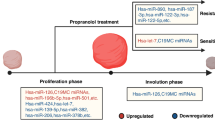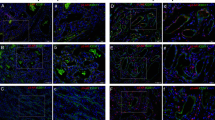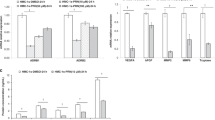Abstract
Background:
Infantile hemangioma (IH) is the most frequent vascular tumor of early childhood. Recently, propranolol, a nonselective β1- and β2-adrenoceptor inhibitor, was introduced into the therapy of severe proliferating IH with excellent results. However, the underlying mechanism of action of propranolol is still unclear.
Methods:
We performed immunohistochemistry for cluster of differentiation 31 (CD31), D2-40, glucose transporter-1 (GLUT-1), and Ki67 in order to characterize 21 vascular anomalies (nine IH, seven venous malformations (VMs), and five lymphatic malformations (LMs)). Furthermore, we analyzed the expression of β1-, β2-, and β3-adrenoceptor mRNA in these specimens as well as in hemangioma-derived stem cells by quantitative real-time PCR (qPCR).
Results:
We show that the expression of β1-adrenoceptor mRNA is 10.7-fold higher in IH independent of the proliferative or regressive phase as well as 2.5-fold higher in hemangioma-derived stem cells as compared with β2-adrenoceptor mRNA. In LM, the expression of β2-adrenoceptor mRNA was ninefold higher than that of β1-adrenoceptor mRNA. VM showed low expression levels of all β-adrenoceptor mRNAs, and β3-adrenoceptor mRNA was hardly detectable in any specimens examined.
Conclusion:
These results provide the first evidence of distinctions between IH and vascular malformations with regard to β-adrenoceptor subtype mRNA levels.
Similar content being viewed by others
Log in or create a free account to read this content
Gain free access to this article, as well as selected content from this journal and more on nature.com
or
References
Léauté-Labrèze C, Dumas de la Roque E, Hubiche T, Boralevi F, Thambo JB, Taïeb A . Propranolol for severe hemangiomas of infancy. N Engl J Med 2008;358:2649–51.
Rössler J, Wehl G, Niemeyer CM . Evaluating systemic prednisone therapy for proliferating haemangioma in infancy. Eur J Pediatr 2008;167:813–5.
Storch CH, Hoeger PH . Propranolol for infantile haemangiomas: insights into the molecular mechanisms of action. Br J Dermatol 2010;163:269–74.
Annabi B, Lachambre MP, Plouffe K, Moumdjian R, Béliveau R . Propranolol adrenergic blockade inhibits human brain endothelial cells tubulogenesis and matrix metalloproteinase-9 secretion. Pharmacol Res 2009;60:438–45.
Hajighasemi F, Hajighasemi S . Effect of propranolol on angiogenic factors in human hematopoietic cell lines in vitro. Iran Biomed J 2009;13:223–8.
Frieden IJ, Haggstrom AN, Drolet BA, et al. Infantile hemangiomas: current knowledge, future directions. Proceedings of a research workshop on infantile hemangiomas, April 7–9, 2005, Bethesda, Maryland, USA. Pediatr Dermatol 2005;22:383–406.
North PE, Waner M, Mizeracki A, Mihm MC Jr . GLUT1: a newly discovered immunohistochemical marker for juvenile hemangiomas. Hum Pathol 2000;31:11–22.
Steven M, Kumaran N, Carachi R, Desai A, Bennet G . Haemangiomas and vascular malformations of the limb in children. Pediatr Surg Int 2007;23:565–9.
Greenberger S, Boscolo E, Adini I, Mulliken JB, Bischoff J . Corticosteroid suppression of VEGF-A in infantile hemangioma-derived stem cells. N Engl J Med 2010;362:1005–13.
Chisholm KM, Chang KW, Truong MT, Kwok S, West RB, Heerema-McKenney AE . β-Adrenergic receptor expression in vascular tumors. Mod Pathol 2012;25:1446–51.
DeGeorge BR Jr, Koch WJ . Beta blocker specificity: a building block toward personalized medicine. J Clin Invest 2007;117:86–9.
Takahata Y, Takarada T, Iemata M, et al. Functional expression of beta2 adrenergic receptors responsible for protection against oxidative stress through promotion of glutathione synthesis after Nrf2 upregulation in undifferentiated mesenchymal C3H10T1/2 stem cells. J Cell Physiol 2009;218:268–75.
Gilsbach R, Brede M, Beetz N, et al. Heterozygous alpha 2C-adrenoceptor-deficient mice develop heart failure after transverse aortic constriction. Cardiovasc Res 2007;75:728–37.
Author information
Authors and Affiliations
Corresponding author
Rights and permissions
About this article
Cite this article
Rössler, J., Haubold, M., Gilsbach, R. et al. β1-Adrenoceptor mRNA level reveals distinctions between infantile hemangioma and vascular malformations. Pediatr Res 73, 409–413 (2013). https://doi.org/10.1038/pr.2013.16
Received:
Accepted:
Published:
Issue date:
DOI: https://doi.org/10.1038/pr.2013.16
This article is cited by
-
Signaling pathways in the development of infantile hemangioma
Journal of Hematology & Oncology (2014)
-
Medikamentöse Behandlungsansätze für infantile Hämangiome und lymphatische Malformationen
HNO (2014)



